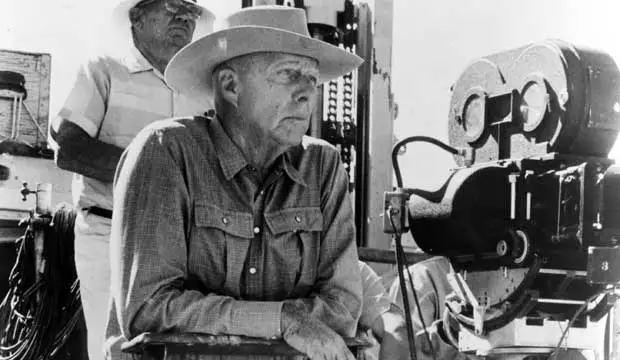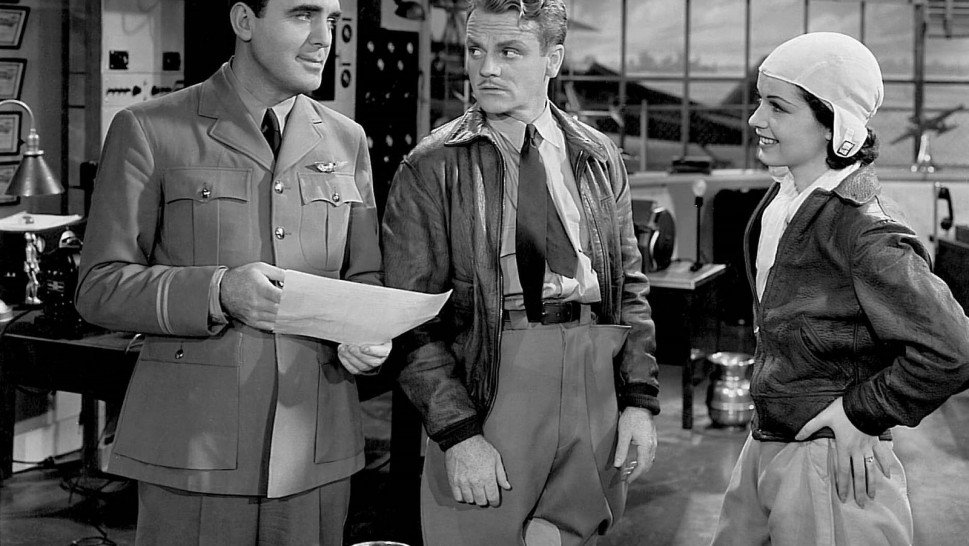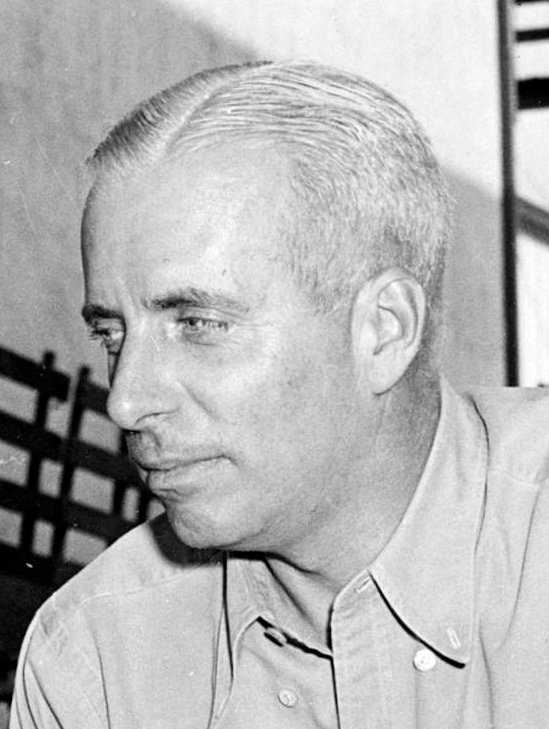Howard Hawks Biography

Howard Hawks, born in 1896 in Indiana and passing away in 1977 in California, was an American film director known for his consistent style across various movie genres. Despite initially being viewed as a skilled but unremarkable director, he gained acclaim during the 1960s and ’70s when French New Wave filmmakers celebrated him as a Hollywood auteur.
Hawks directed 33 sound films, always remaining independent from studio contracts but utilizing studio talent for his projects. His distinct style was so recognizable that his movies were easily identifiable as his own from the very start. Throughout his career, he tackled a wide range of genres including westerns, comedies, war films, and more, often achieving remarkable success.
While not every film he made became a classic, Hawks’s versatility and knack for storytelling set him apart from his contemporaries, earning him a reputation as one of the most accomplished directors in American cinema history.
Howard Hawks Early life and background

Howard Winchester Hawks was born into a wealthy family in Goshen, Indiana. His father, Frank Winchester Hawks, was a prosperous paper manufacturer, and his mother, Helen Brown, came from an affluent industrialist background. The Hawks family had deep roots in American history, tracing back to ancestors who migrated from England to Massachusetts in the 17th century.
Howard was the oldest of five siblings, and the family enjoyed a privileged lifestyle thanks to their wealth, particularly from the successful Goshen Milling Company. However, tragedy struck when Howard’s youngest sister, Helen, passed away unexpectedly in 1911.
In his youth, the family frequently moved between Wisconsin and California due to his mother’s health issues. They settled in Pasadena, California, where Howard attended school and developed a passion for coaster racing. Despite being an average student, he excelled in sports, winning the United States Junior Tennis Championship at the age of 18.
After graduating from high school, Howard attended Cornell University, where he studied mechanical engineering. However, he was more interested in gambling, drinking, and reading novels than focusing on his studies. His time at Cornell was interrupted by World War I, during which he served as a lieutenant in the Aviation Section of the U.S. Signal Corps, teaching pilots to fly.
Hawks’ experiences during the war influenced his later work in aviation-themed films. Upon returning to civilian life, he ventured into the film industry, initially working on a Cecil B. DeMille production in Hollywood.
Howard Hawks Career

Howard Hawks got into the movie world because of his love for flying. Back in 1916, he crossed paths with Victor Fleming, who was a Hollywood camera guy and had a history with planes too. They met while racing cars, and, well, causing a bit of trouble on the track. This meeting landed Hawks his first gig in the movies, helping out on a film with Douglas Fairbanks. Then, he hopped on another project with Cecil B. DeMille. Hawks even stepped up to direct a scene when the main director didn’t show up!
At just 21, Hawks got behind the camera for real. He teamed up with Mary Pickford and Marshall Neilan to direct his first films. But his filmmaking dreams were put on hold when he joined the army during World War I. He trained pilots and even got a promotion thanks to a visit from Mary Pickford herself!
After the war, Hawks dove back into Hollywood life. He and his brother Kenneth rubbed elbows with the big shots in town like Allan Dwan and Irving Thalberg. Hawks even bankrolled a series of comedy shorts and later started his own production company. But it wasn’t all smooth sailing. The company fizzled out, and Hawks decided to focus on directing instead of producing.
Throughout the 1920s, Hawks hung out with a wild bunch of friends in Hollywood. He made connections, learned the ropes, and even landed a job as a story editor. But he got tired of the studio scene and wanted more control over his work. So, he struck out on his own, making deals with different studios for his projects.
By the time sound movies came along, Hawks had already made a name for himself. His first big hit in the sound era was “The Dawn Patrol”, a gripping war film that set box office records. From there, he tackled different genres, from gangster flicks to screwball comedies, always leaving his mark on each film.
Hawks wasn’t afraid to take risks or challenge the status quo. He pushed boundaries in storytelling and brought out the best in his actors. Whether it was crafting complex characters or staging thrilling action scenes, Hawks knew how to keep audiences on the edge of their seats.
As the years went by, Hawks kept churning out hit after hit, from iconic classics like “Bringing Up Baby” to epic adventures like “Rio Bravo”. He worked with some of Hollywood’s biggest stars, leaving behind a legacy of unforgettable films that still captivate audiences today.
Howard Hawks Final years and death

Howard Hawks had a pretty eventful love life. He got married three times! First to actress Athole Shearer, then to socialite Slim Keith, and finally to actress Dee Hartford. With Athole Shearer, he had two kids named Barbara and David. David even worked behind the scenes on the TV show MAS*H. From his second marriage with Slim Keith, he had a daughter named Kitty. And with Dee Hartford, he had a son named Gregg, named after a famous cinematographer.
Aside from making movies, Hawks had some cool hobbies. He loved cars and motorcycles, even building a race car that won a big race in 1936. He also enjoyed hitting the road on his motorcycle with famous pals like Barbara Stanwyck and Gary Cooper. Hawks and his son Gregg were part of a motorcycle club called Checkers. And get this, he kept riding until he was 78!
But wait, there’s more! Hawks was tight with some big-name writers like Ben Hecht, Ernest Hemingway, and William Faulkner. He actually helped Faulkner kick off his screenwriting career and even got him in with the famous Algonquin Round Table crew. Hawks and Faulkner bonded over flying, drinking, and making movies together. And speaking of Hemingway, Hawks almost directed a movie based on one of his books, but it never happened.
Oh, and Hawks was into politics too. He backed Thomas Dewey in the 1944 presidential election.
Howard Hawks Personal life

Howard Hawks was married three times. His first wife was Athole Shearer, an actress and the sister of Norma Shearer. They were married from 1928 to 1940 and had two children together, Barbara and David. David later worked as an assistant director on the TV series MAS*H. Howard’s second marriage was to Slim Keith, a socialite and fashion icon, lasting from 1941 to 1949. His third wife was actress Dee Hartford, and they were married from 1953 to 1959. With Dee, Howard had a son named Gregg, named after the cinematographer Gregg Toland.
Besides his passion for filmmaking, Howard Hawks had many other interests. He was fascinated by flying machines and even built a race car that won the 1936 Indianapolis 500. He also enjoyed riding motorcycles, often with friends like Barbara Stanwyck and Gary Cooper. Howard and his son Gregg were both members of the Checkers Motorcycle Club. Despite his age, Hawks continued riding motorcycles until he was 78. Apart from these hobbies, he was also fond of golf, tennis, sailing, horse racing, carpentry, and silversmithing.
Howard Hawks had close friendships with several American writers, including Ben Hecht, Ernest Hemingway, and William Faulkner. He took pride in discovering Faulkner and introducing him to influential literary circles like the Algonquin Round Table. Hawks and Faulkner shared interests in flying, drinking, and filmmaking. Faulkner even wrote five screenplays for Hawks, starting with “Today We Live” and ending with “Land of the Pharaohs.” Hawks was also close to Hemingway, although he struggled to forgive him for his suicide. Despite this, he planned a film project about Hemingway and his friend Robert Capa but never completed it.
In politics, Hawks supported Thomas Dewey in the 1944 United States presidential election.
Howard Hawks Style

Howard Hawks was a director who could do it all. He made funny movies, serious ones, crime dramas, sci-fi flicks, film noir, and Westerns. He had a simple rule for what made a good movie: three great scenes and no bad ones. He thought a good director was someone who didn’t annoy you. Basically, he wanted his movies to be enjoyable and easy to watch.
Even though Hawks wasn’t really into feminism, he showed women in his movies as strong characters, not just as sidekicks. This was pretty rare back in the 1920s and is seen as a big deal even today. He also liked to mix serious stuff with humor in his films.
Orson Welles once said that Hawks made movies like prose, while another famous director, John Ford, made them like poetry. Even though Hawks worked in lots of different movie genres, he always put his own twist on things. For example, his adventure movies often had a love story at the heart of them, and his Westerns sometimes turned into funny conversations. Some people say Hawks’ movies helped Hollywood break away from being too cheesy or sentimental. Instead, he made movies that were real and honest.
Howard Hawks Writing and producing

Besides being a director, Howard Hawks also had a hand in writing most of his movies. Sometimes, he’d even change bits of the script while filming. But because of a rule by the Screen Writer’s Guild, directors like Hawks couldn’t officially get credit for writing. Even though someone else got the credit for writing “Gone with the Wind,” Hawks actually helped write it along with other big Hollywood names like David O. Selznick and Ben Hecht. He did this for a bunch of other movies too, like “Underworld,” “Morocco,” “Shanghai Express,” and “Gunga Din.”
Hawks didn’t just direct and write, though. He also produced a lot of his own movies. He liked doing this because it meant he could have more control over everything, from the script to who acted in the film. Sometimes he’d even leave a movie if he wasn’t in charge of producing it. But even though he produced many films, he always saw himself as a director first. You can tell because on some movie cards, it says “Directed and produced by Howard Hawks,” but “produced” is written smaller. He helped launch the careers of many famous actors, like Lauren Bacall, James Caan, and Carole Lombard.
Howard Hawks Filmography

Films directed
| Year | Title | Studio | Genre | Cast | Notes | Other roles |
|---|---|---|---|---|---|---|
| 1926 | The Road to Glory | Fox | Drama | May McAvoy | Lost film | Writer |
| 1926 | Fig Leaves | Fox | Comedy | George O’Brien, Olive Borden | Colour scenes included | Writer |
| 1927 | The Cradle Snatchers | Fox | Comedy | Louise Fazenda, Diane Ellis | ||
| 1927 | Paid to Love | Fox | Comedy | George O’Brien, Virginia Valli, William Powell | ||
| 1928 | A Girl in Every Port | Fox | Comedy | Victor McLaglen, Robert Armstrong | Writer | |
| 1928 | Fazil | Fox | Romance | Charles Farrell, Greta Nissen | ||
| 1929 | Trent’s Last Case | Fox | Detective | Raymond Griffith | ||
| 1928 | The Air Circus | Fox | Drama | Arthur Lake, Sue Carol | Co-directed with Lewis Seiler / Lost film | |
| 1930 | The Dawn Patrol | First National / Vitaphone | War | Richard Barthelmess, Douglas Fairbanks Jr. | Writer | |
| 1931 | The Criminal Code | Columbia | Crime | Walter Huston, Phillips Holmes | Producer | |
| 1932 | Scarface | Caddo Company | Crime | Paul Muni | Co-directed with Richard Rosson / Producer, Writer | Producer, Writer |
| … | … | … | … | … | … | … |
This table shows the movies directed by Howard Hawks throughout his career, along with details like the year of release, title, studio, genre, cast, notes, and any other roles he had in the production.
Films produced only
| Year | Title | Studio | Genre | Cast | Notes |
|---|---|---|---|---|---|
| 1943 | Corvette K-225 | Universal Pictures | War | Randolph Scott, Ella Raines, Barry Fitzgerald | Producer, directed by Richard Rosson |
| 1951 | The Thing from Another World | Winchester Pictures | Science fiction | Kenneth Tobey, Robert Cornthwaite, Dewey Martin | Producer, directed by Christian Nyby |
This table lists two movies, “Corvette K-225” released in 1943 and “The Thing from Another World” released in 1951. It provides information about the studio, genre, cast, and any additional notes such as the roles of Howard Hawks in the production.
Documentary appearances
Here’s a simplified version of the table:
| Year | Title | Notes |
|---|---|---|
| 1967 | Cinema | Episode: “Howard Hawks” |
| 1970 | Plimpton! Shoot-Out at Rio Lobo | Making-of documentary |
| 1972 | The Men Who Made the Movies: Howard Hawks | Documentary |
| 1977 | Hollywood Greats | Episode: “Humphrey Bogart” |
This table lists four entries related to films or documentaries. It includes the year of release, the title of the production, and any additional notes about each entry.
Unfinished projects
| Year | Title | Studio | Genre | Cast | Notes |
|---|---|---|---|---|---|
| 1932 | La foule hurle | Warner Bros. | Drama | Jean Gabin | French-language version of “The Crowd Roars” directed by John Daumery, featuring footage from Hawks’ film |
| 1933 | The Prizefighter and the Lady | MGM | Romance | Max Baer, Myrna Loy | Hawks resigned, replaced by W.S. Van Dyke |
| 1934 | Viva Villa! | MGM | Western | Wallace Beery | Hawks resigned, replaced by Jack Conway |
| 1943 | The Outlaw | Howard Hughes Productions | Western | Walter Huston, Jack Buetel, Thomas Mitchell, Jane Russell | Hawks resigned, replaced by Howard Hughes |
This table lists four entries related to films. It includes the year of release, the title of the production, the studio involved, the genre, the cast, and any additional notes about each entry.
Howard Hawks Influence and legacy

In the 1950s, a film enthusiast named Eugene Archer wanted to write a book about important American directors like John Ford. But when he discovered Cahiers du Cinéma, a French film magazine, he realized that the French were more interested in directors like Alfred Hitchcock and Howard Hawks. Although books about Hawks didn’t appear until the 1960s, and a full biography wasn’t published until 1997, Hawks was considered by some to be the least known and appreciated Hollywood director of his stature.
One reason for this lack of recognition might be because Hawks didn’t stick to one particular genre like other famous directors did. He worked in many genres, from gangster movies to romantic comedies to Westerns. Instead of tying himself to major studios, Hawks often produced his own films, giving him more creative freedom. However, his straightforward storytelling and simple narratives may have contributed to his under-recognition.
Critics sometimes pigeonhole Hawks as an action director with a masculine bias. But in reality, Hawks often left action scenes to second-unit directors and preferred working indoors. Unlike other directors, there’s no clear connection between his visual style and storytelling method. His camera work was unobtrusive, focusing more on collaboration and improvisation.
Despite the lack of critical acclaim during his lifetime, Hawks influenced many filmmakers, including Robert Altman, John Carpenter, and Quentin Tarantino. French critics admired his work, and some British critics, like Robin Wood, praised films like “Rio Bravo.” His films are known for their sly humor, subtle masculinity, and disdain for pretentiousness.
Hawks’ impact on cinema is undeniable, with directors like Martin Scorsese, Robert Altman, and Jean-Luc Godard considering him one of the greatest American filmmakers of all time. His ability to effortlessly navigate various genres and infuse his films with depth and humor made him a beloved figure in the world of cinema.